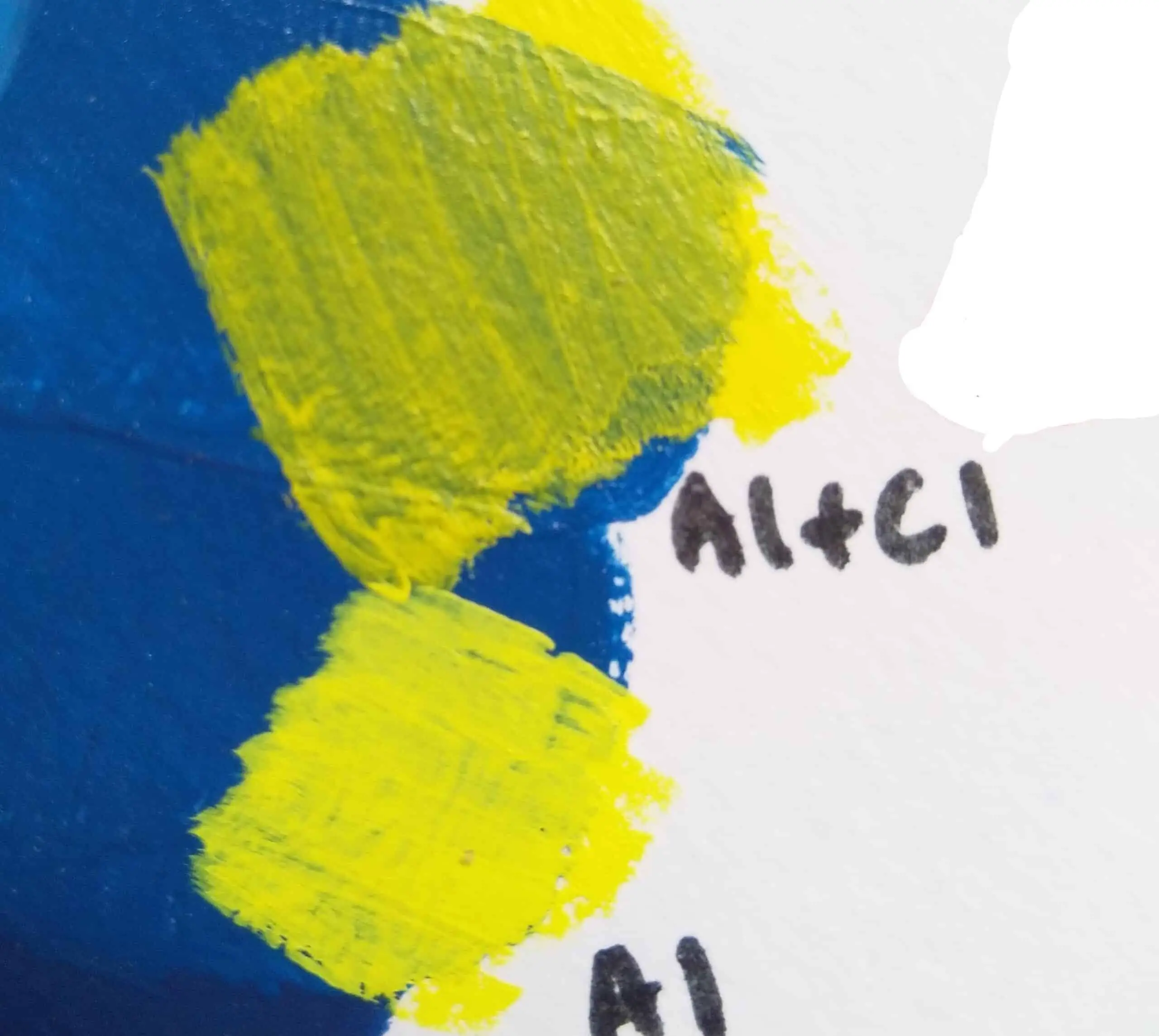If you are a paint enthusiast like me or most other artists you may want to try other acrylic paint brands. However as you cannot purchase all the colors you want from one brand, you might wonder if you can mix different brands of acrylic paint. Here is the truth about it.
You can mix different brands of acrylic paint. Mixing acrylic paints that match in opacity, permanency, and lightfastness gives the best results as it will not diminish the quality of the mixed color. Liquitex Basics can be mixed with artist-grade acrylics giving the best results.
When intermixing different acrylic paint brands the mixed color will have the properties of all the acrylic paint brands mixed.
Can you mix different brands of acrylic paint?
I have asked a group of artists if they intermix different acrylic paint brands and whether it is okay to do so. 20out of 20 artists said that they all intermix between different brands and did not see any miss effects of it.
You can mix brands as long as all the paints you’re mixing are acrylic. I mix brands all the time. (You do not want to mix acrylic paint and oil paint together.)
Lauren Kristine at laurenkristineart.com
However, when you mix two brands that are drastically different in quality, you might see the difference. Such as mixing craft acrylic paint like Apple Barrel with Golden heavy body acrylic paint. The mixed color will have qualities of both Apple Barrel and Golden acrylic paint such as the opacity and finishing.
But as a Golden heavy body acrylics are stronger in opacity and finishings, the mixed color will take more of the qualities of Golden acrylic paint. However, it will reduce the quality of Golden artist-grade acrylic paint by mixing it with craft-quality acrylic paint.
While we cannot guarantee that there could potentially be some minor compatibility issues such as unexpected thickening or a difference in performance with the mixtures, generally speaking, it is possible to mix different brands of waterborne acrylic paints.
Scott Bennett, Materials Specialist for GoldenPaints.com
However, according to Golden paint manufacturers there can be unexpected thickening or a difference in the performance of paint mixtures made by mixing different water-based acrylic brands. This is a minor possibility but not very common.
What happens when you mix different acrylic paint brands?
Now let’s see what you can expect by intermixing acrylic paints with different qualities. This may happen with a lot of artists, especially when switching from low-quality acrylic paint brands to higher quality ones.
Can you mix craft acrylic paint?
You can mix the same or different brands of craft acrylic paints. As almost all craft acrylic paints have a similar consistency the mixed color also look the same. Here I have mixed magenta and lemon yellow acrylic colors from the same (C2) and two different craft acrylic brands (C1 and C2). Following are my results.
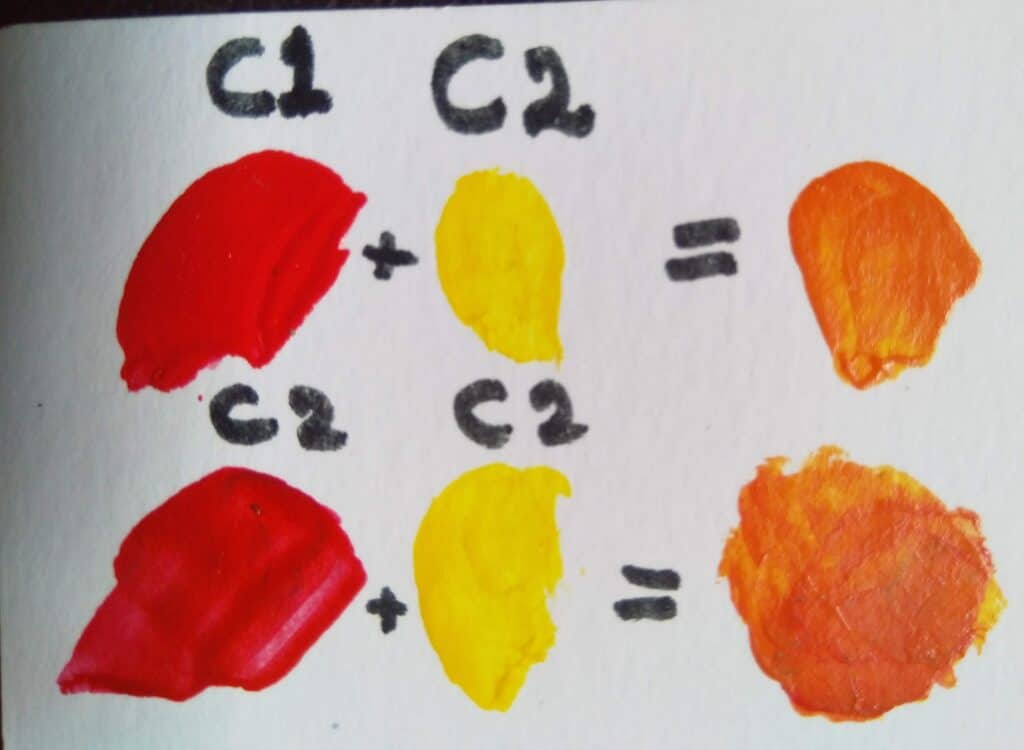
As you can see the result you get is the same. The opacity, finishing, and coverage are almost the same when mixed between the same or different brands.
Mixing with artist-grade and student-grade acrylic paint…
Then I tried mixing craft acrylic with student-grade and artist-grade acrylic paint. In this case, I used cadmium lemon artist-grade acrylic (A1) from Winsor and Newton and student-grade cadmium yellow (S1) from a brand called Sakura.
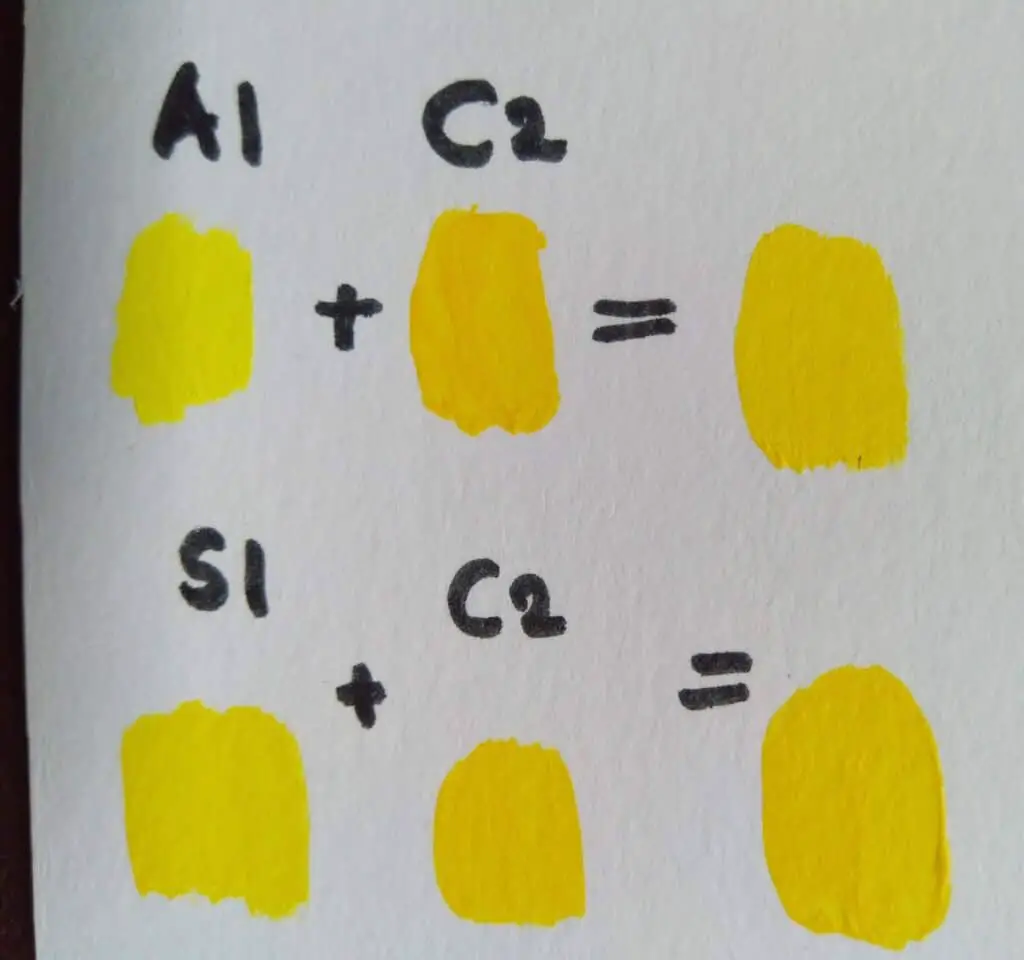
You might not see a clear difference in this image of the color mixtures. However, mixing artist-grade acrylic paint with craft acrylic paint is not a good idea. It reduced the quality of artist-grade acrylic paint. The mixed color opacity is low or transparent. You can see that in the below image.
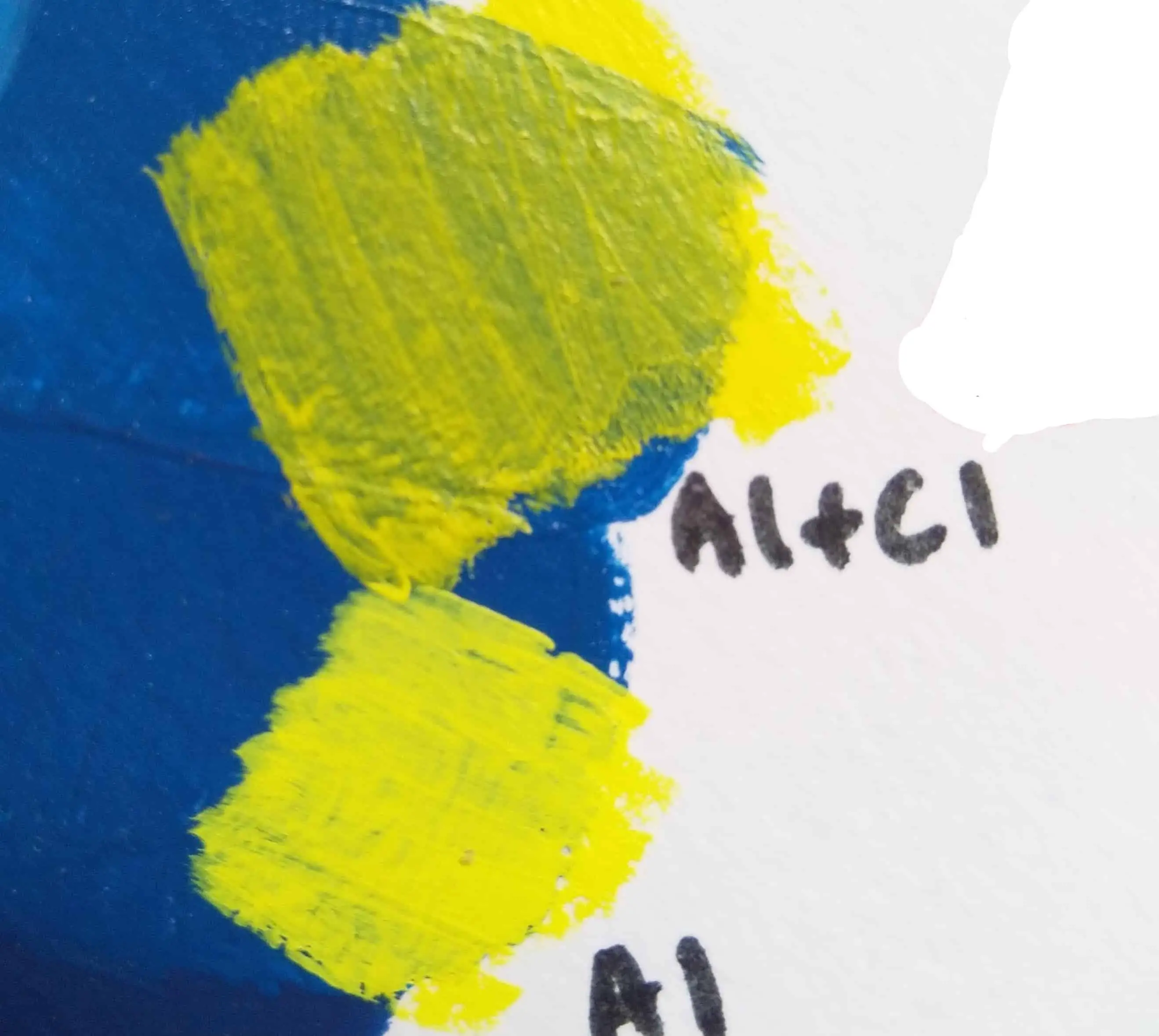
Also when you mix artist-grade and craft quality acrylic paints the permanency and lightfastness can be affected. Craft quality acrylic paints are generally not lightfast and permanent. While artist-grade acrylic paints are permanent and lightfast. The mixed color may have less permanency and lightfastness because of craft-quality acrylic paint.
The same applies to mixing student grade and craft acrylic paint. Student grade acrylic paints have a slightly high quality than craft acrylic paints. So the quality, permanency, opacity, and lightfastness can be reduced when craft and student grade acrylic paints are mixed. This effect is visible if you are using a good student-grade acrylic brand such as Liquitex Basics.
I have written a whole article about the 17 pros and cons of acrylic paint. You can find all the important aspects of acrylic paint there.
Can you mix student-grade acrylic paint?
You can also intermix between the same and different brands of student-grade acrylic paints. I have discussed in the previous section about mixing student-grade and artist-grade acrylic paint brands. Now let’s see what to expect when student-grade and artist-grade acrylic paints are mixed.
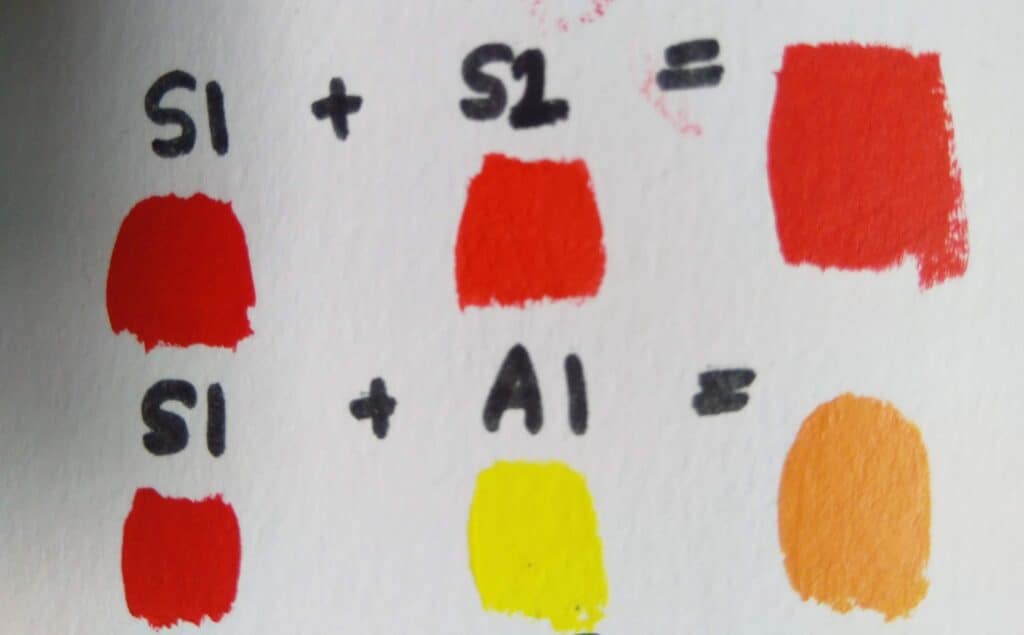
In the image, you might not see the difference between mixing two different student-grade acrylic paint brands. However, the mixed color gets the properties of the most overpowering acrylic paint brand. In this case, I mixed pyrrole red from Liquitex Basics (S1) and cadmium red from Daler Rowney System 3 acrylic paint.
The Liquitex Basics was most overpowering so the mixed color took most properties of Liquitex Basics. Overall the mixed color is the same as the initial colors without any loss of quality. The mixed color opacity and finishing were also similar to the initial colors.
However, you still have to check the permanency and lightfastness of the two colors. Both System 3 and Liquitex Basics are made from lightfast and permanent pigments so mixing them has no effect on the quality of the mixed color.
Mixing with artist-grade acrylic paint…
Mixing student-grade acrylic and artist-grade acrylics is not a good idea. As you can see in the image the mixed color is more transparent than the initial colors. However, if you do not have the choice then mixing artist-grade acrylic paint with a good quality student-grade acrylic brand like Liquitex basics will be okay.
I have written a whole article about a review on Liquitex Basics. You can find each aspect of Liquitex Basics in detail there and why is such as good student grade acrylic brand.
Also, student-grade acrylic paints are a good choice for under paintings. Most artists use student-grade acrylic paint for underpaintings and artist-grade acrylics for top paint layers.
Can you mix artist-grade acrylic paint?
I have discussed in the previous sections about mixing artist-grade acrylic paint with craft quality acrylics and student-grade acrylic paints. So you should not absolutely mix artist-grade acrylic paint with craft-quality acrylic paint. However, mixing artist-grade acrylic paint with good quality student-grade acrylic paint like Liquitex Basics will be okay.
This is to protect the qualities of artist-grade acrylic paint such as opacity, lightfastness, and permanence. Other than that there are no caveats of mixing with different quality paint such as breaking the paint film.
In the below image you can see the vibrant and rich colors you can get by mixing only artist-grade acrylic paint.

Make a color chart of your own
Making a color chart from the colors you are using is very important, even if you use the same brand or mix different brands. It helps to predict the colors you get and have a better color composition for your artwork. Following is a color wheel I have made for the colors I use. They are student-grade acrylic paints.
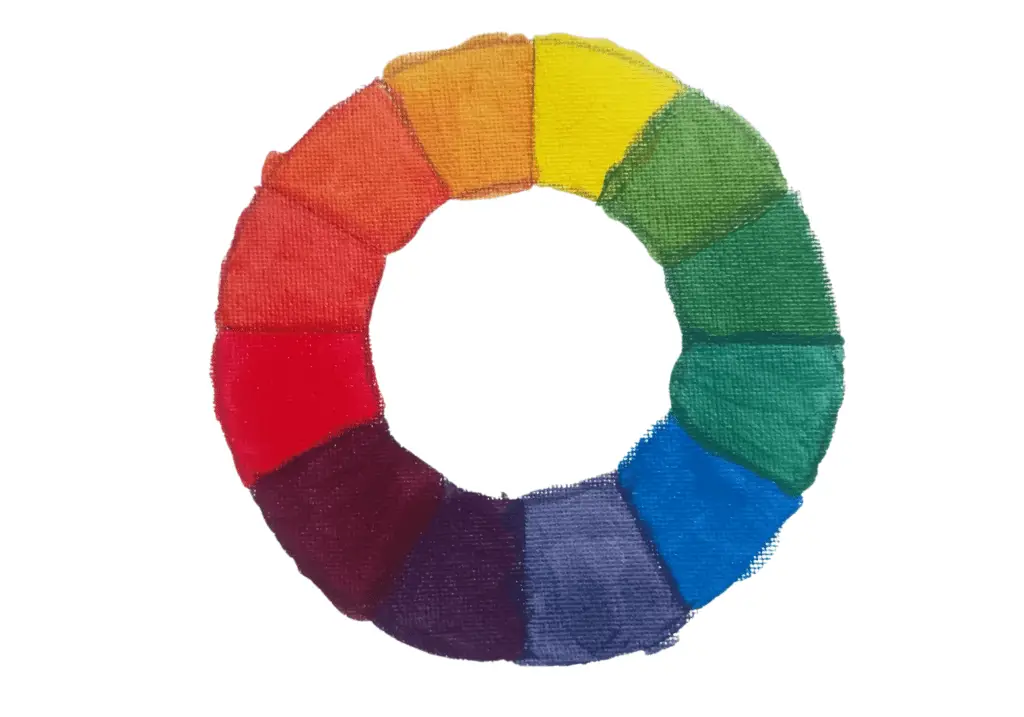
Conclusion
You can intermix different brands of acrylic paints. It is done by most artists. However, be careful when mixing acrylic paints that do not match in lightfastness or permanency as it can affect the longevity of a painting. It is okay to intermix good quality student-grade acrylic brands and artist-grade acrylics. Also intermixing acrylic paints with the same quality has no issues.

